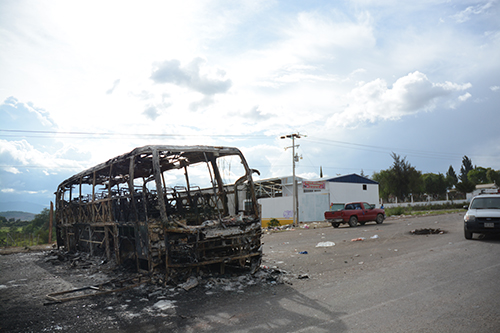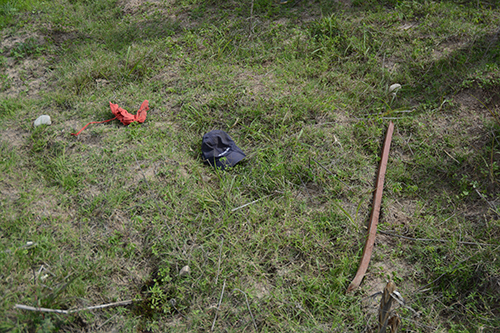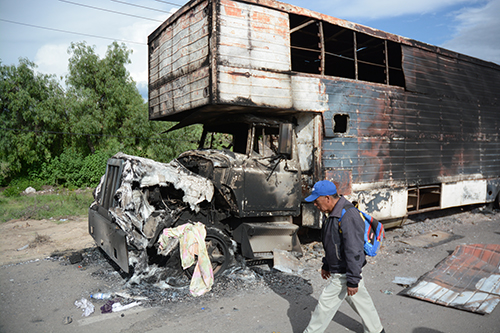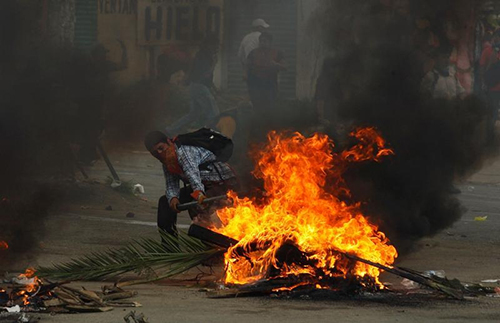The atmosphere in Nochixtlán, a small, rural community in Mexico’s southern state of Oaxaca, was tense on June 20. The day before, members of a dissident teachers’ union had clashed with federal and state police while protesting education reform. Shots were fired and, by the end of the day, nine people had died and dozens more were wounded.
The main highway connecting the town with the state capital, Oaxaca, about 50 miles (80 km) further to the southeast, has been blocked since by the burned-out carcasses of cars and trucks, and piles of dirt, rocks, and wood. Dozens of residents and striking teachers manning the blockade have painted anti-government slogans on the concrete of an overpass and are wary of anyone trying to pass–including reporters.
“We don’t want any government media here,” Lucia Avendaño Mayoral, a spokesperson for the teachers manning the blockade, told CPJ two weeks ago. “They only tell the official version of the stories, but they don’t give the complete picture. We want the truth to be told.”
CPJ, several foreign outlets, and a number of smaller, independent Mexican media were allowed to stay after identifying themselves to the protesters. But some of the teachers played hardball with others. Cameraman Fernando Albarrán and editor Pedro Cortés, of TV Azteca, the smaller of two major networks that dominate Mexican television, were held by protesters for about five hours on June 21, according to reports.
The protesters told the reporters to shoot footage of the blockade and other key areas, and demanded that TV Azteca give them 15 minutes on primetime news to tell their side of the story, according to news reports, which were confirmed by several protesters present at the blockade in Nochixtlán.
“They have not been telling the truth about what happened here, so we detained them. We needed them to tell the right story”, William Velázquez, a 34-year old teacher and union member from Nochixtlán, told CPJ. “We did not harm them, and we won’t do that to journalists. But we do want them to be truthful.”
The network refused to meet their demands, and Albarrán and Cortés were later released unharmed, members of Mexico’s federal human rights commission, CNDH, who were present at the time, told CPJ.
These challenges are connected to what is, in effect, an “education war” in the southern Mexican states of Chiapas, Guerrero and Oaxaca. Members of the National Coordinator of Education Workers (CNTE), a dissident wing of the larger National Union of Education Workers (SNTE), are blocking key highways in dozens of locations to protest sweeping education reforms that President Enrique Peña Nieto’s government introduced in 2013 and the arrest last month of two leaders of the CNTE’s local chapter in Oaxaca state.
The protests turned violent on June 20, when striking teachers and their supporters clashed with law enforcement. The brunt of the violence was felt in Nochixtlán where, according to reports, nine people died. The conflict has polarized public opinion and has since extended to other regions, including the north and the capital, where protests started last week.
The government and the union have agreed to negotiations in Mexico City in the wake of the violence but neither are close to reaching an agreement over education reform, reports said.
Slideshow
« Previous Image | Next Image »

Residents of Nochixtlán walk on the main road that leads to the state capital of Oaxaca. A truck blocks traffic from passing. Nochixtlán was the center of clashes between protesters and police in June. (Jan-Albert Hootsen)
A protester in Nochixtlán shows the shells of rounds allegedly fired by police during clashes. Nine people were killed in unrest there on June 19. (Jan-Albert Hootsen)
A burned-out bus blocks the road into Nochixtlán. Those manning the blockades are wary of letting anyone, including press, pass. (Jan-Albert Hootsen)
A stick and a scarf mark the place where one of the nine people killed by gunfire in Nochixtlán died on June 19 during clashes between protesters and police. (Jan-Albert Hootsen)
The wreckage of a truck is used by protesters to block the main road into Nochixtlán. Journalists trying to cover the unrest have been harassed and, in some cases, held by protesters. (Jan-Albert Hootsen)
To journalists, covering what may well be one of the defining social conflicts in Mexico has proven difficult and, in some instances, dangerous. Reporters face violence from unknown attackers as a consequence of lawlessness during the protests, and aggression from law enforcement and union members.
The most serious incident was the murder of Elidio Ramos Zárate, a reporter for the local newspaper El Sur. CPJ documented how he was shot dead by unknown assailants on June 20, shortly after covering a blockade of protesting teachers in Juchitán, a small city in southern Oaxaca. Ramos Zárate and other reporters had received threats from masked individuals at the blockades, El Sur‘s editor-in-chief, Luciano Pacheco, told CPJ. Raúl Cano López, the brother of the owner of a local newspaper, Punto Crítico, was also killed in the attack, though it remains unclear whether he was targeted.
Journalists have also reported cases of police harassment and attacks while covering the protests. On July 5, Ana Rosete, a reporter for the Mexico City newspaper La Crónica de Hoy, said that she was repeatedly hit by policemen when she covered a CNTE protest in the city. The incident was partly recorded on video, in which Rosete can be heard confronting the policemen, accusing them of having hit her. Three days earlier, María Meléndez, a photographer for the La Jornada newspaper, said she was attacked by police while covering a protest in the capital, according to reports. Both women said they reported the incidents to the authorities, which have not publicly commented on either incident. Mexico City police did not immediately respond to CPJ’s request for comment.
Members of the union have arbitrarily held journalists they consider to be hostile to their cause on several occasions. On June 10, striking teachers detained eight reporters for several hours in Tabasco state, according to reports. And in May, reporters in Oaxaca sent an open letter to the CNTE, accusing union members of acting aggressively against reporters covering strikes and protests. At least some of those actions do not part appear to be part of the union’s official protests. When asked about the detention of the two TV Azteca reporters, a spokesperson of the Oaxacan chapter of the CNTE told Mexican media on June 22 that it condoned the “abductions.”
Avendaño Mayoral and several members of the union, speaking unofficially, confirmed to CPJ that reporters have been detained and that, in the wake of the June 19 clashes, some union members, residents, and protesters in Nochixtlán are resistant to allowing what they believe to be pro-government media to cover the protests. The union members with whom CPJ spoke said there is a widely supported notion among the striking teachers that some outlets are considered hostile to their cause, notably broadcasters including TV Azteca and Televisa, and the national newspapers El Universal and Milenio. Journalists from these outlets are not given the same access as press considered more neutral or friendly to the union or, in cases such as that of the TV Azteca reporters in Nochixtlán, could even be victim to temporary detention, union members said.
“The protest marches have made it very difficult for journalists to work,” Pacheco, of El Sur, told CPJ. “It is a context in which journalists are completely unprotected. They can be attacked by the authorities, by members of the union, by anyone who wants to do something to them.”
It is not uncommon for Mexican journalists to be attacked during protest marches. But some journalists in Oaxaca told CPJ that the highly polarized and politicized nature of the protests may push journalists further into harm’s way.
Octavio Enríquez, the coordinator of Tu Un Ñuu Savi, an indigenous station in the Oaxacan town of Huajapán told CPJ that local journalists are often the victim of intimidation. “If you sympathize with the union, you’re no friend of the federal police,” he said. “And as the protests increase, so do the risks for those who voice their opinion against the authorities.”
[Reporting from Nochixtlán]
